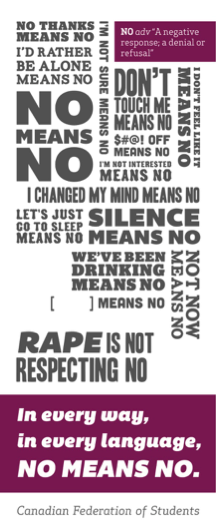No means No
No Means No
Many people have heard the saying “no means no”: When someone says no to a sexual act, the other person(s) must respect that no, otherwise it is sexual violence.
There are many ways to communicate no, including body language. The absence
of a spoken “no” does not mean yes. Sometimes people aren’t able to say the word
“no”. The person must freely agree to each sex act. Anything but a clear “yes”, is no.
The idea that saying the word “no” is the only way to stop unwanted sexual activity teaches that people are always ready and willing to engage in sexual activity unless they clearly and forcefully say “no”. It also allows people to ignore non-verbal cues such as body language, and the other ways that people say no.
The idea that only a verbal “no” means no enforces the harmful idea that it is up to the person who is on the receiving end of the sexual advances to ensure that there is consent. They must play the role of gatekeeper, always alert and ready to push
back against unwanted advances. This can be tiring, triggering, painful, and more.
When Yes Doesn’t Mean Yes
Consent is also about working to address power imbalances and creating space for someone to say no, verbal or otherwise. Not being able to say no can lead someone to say yes when they don’t want to. They may say yes:
- If there is a power imbalance amongst the people involved.
- If they have been socialized to submit or please or believe it’s their duty.
- If they have been coerced (i.e. convinced, pressured, or threatened).
- If they are under the influence of alcohol or drugs.
- If they are fearful that they may be physically harmed or otherwise punished, bullied or shamed if they say no.
- To avoid an argument or violent outburst.
- To get out of a dangerous situation.

Some Examples of When People Can't Say No Include:
Reflection Activity:
What are other circumstances when someone might not be able to say “no”? Add your thoughts to your notes using the button.